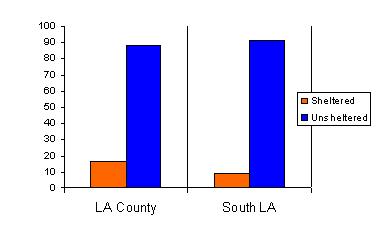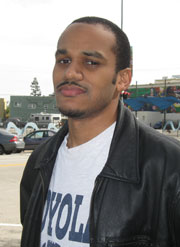 The US Department of Housing and Urban Development gave the greater Los Angeles area $73 million in grants to help the homeless, but it won’t be enough to solve the crisis. Homeless service organizations are reporting an increase in homeless families, and are struggling to make do with limited resources. Parts of this story were featured on Annenberg Radio News; click below to listen.
The US Department of Housing and Urban Development gave the greater Los Angeles area $73 million in grants to help the homeless, but it won’t be enough to solve the crisis. Homeless service organizations are reporting an increase in homeless families, and are struggling to make do with limited resources. Parts of this story were featured on Annenberg Radio News; click below to listen.
- Los Angeles Homeless Service Authority
- Beyond Shelter
- Unsheltered, a special report on homelessness
in South L.A.
Janelle Burdett is 64 and homeless for the first time. After 15 years working as a nurse’s assistant, she was laid off in December. “Because I had lost my job and I didn’t have any money to pay my rent I got evicted," Burdett said while waiting to apply for senior housing. "I have always worked. I raised my son, I’ve always worked, this has never, this has never happened to me."
.jpg)
Burdett waits to see if she is eligible for senior housing aid.
More Money, More Problems
39 West Apartments
Funding: $175,000.00
Run by: A Community of Friends
Funding: $210,433.00
Run by: A Community of Friends
Funding: $246,780.00
Run by: His Sheltering Arms
2008-09 Funding: $93,310.00
Run by: Project New Hope
2008-09 Funding: $90,395.00
Run by: The Shields for Families
2008-09 Funding: $387,743.00
Run by: Special Services for Groups
2008-09 Funding: $157,436.00
Run by: Testimonial Community Love Center
2008-09 Funding: $136,216.00
Run by: California Council for Veterans Affairs
Several more shelters and resource centers in South Los Angeles will receive money from the new HUD grants. The South Central Access Center run by the Watts Labor Community Action Committee will get more than $250,000. Beyond Shelterwill collect more than $300,000.
These centers do more than help homeless individuals and families find shelter, they also give support to people on the brink of homelessness. They provide outreach work, looking for homeless people that will not or cannot actively seek assistance. The new grants will help them improve access to the area’s limited resources.
Affordable housing and shelter space are always in high demand in South L.A. The surge in foreclosures coupled with the economic crisis has created a new generation of homeless, at risk of becoming chronically homeless, permanently stuck in a shelter or on the streets.
“We’ve been seeing an increase over the past 18 months or so, most recently new homeless, families that were in the middle class that are now sliding into homelessness," said Tanya Tull, a national expert on homelessness and founder of Beyond Shelter. "The only difference is we have more interest in the problem, and new exposure of the problem, because it’s beginning to affect the middle class."
The widening mortgage crisis affected low-income neighborhoods long before the economic repercussions hit Wall Street and the middle class. Between April and June 2007, there was an 800 percent increase in foreclosed homes in South L.A., compared with the same three-month period a year earlier, according to Special Services For Groups, an organization that monitors homelessness in South LA and operates several resource centers.
Low-income apartment buildings also had a high rate of foreclosure during this time. Low-rent buildings bought by speculators with bad loans began going into foreclosure, sending dozens of families packing at once. Tull said she worked with residents who could not even get their security deposit back after suddenly being evicted, pushing them deeper into economic calamity. The scarcity of low-income housing options ensured that many of these people would have no place to go.
The new HUD funding will provide 191 new units for the homeless. But these new spaces will be spread out across the county, and will barely impact the number of unsheltered homeless.
The grant has two main components: $37 million for supportive housing, which will provide permanent housing for homeless individuals and families, and an additional $32 million will help pay for shelters, housing vouchers and supportive services. Another $4 million — the balance of the $73 million grant from HUD — will be used to fund emergency shelters only open during the winter months.
HUD grants are typically augmented with city, county, state and private funds. The new state budget already cut programs that help the homeless, like the Emergency Housing Assistance Program. With the city and state facing critical budget gaps, homeless service organizations must do their best with limited resources.
Too many to count
Shelters are so crowded families must share a single room. Shondra Turnbough’s children are too young to be in school, so she has to bring them with her to apply for hotel vouchers at Beyond Shelter’s neighborhood center.
.jpg)
Turnbough waits with her daughters
“I got laid off, right before I had my baby. Right now I’m in a shelter," Turnbough said.
There she shares a room with a mother of two, like herself. She has been looking for housing for over a year now, and fatigue is written into the lines of her face.
Not all homeless families are in the shelter system, and some that are will never get out. There is not enough shelter space to house even half of South L.A.’s unsheltered homeless, according to data from the last homeless census conducted in 2007.
In order to be eligible for HUD funds, the city must conduct a homeless count. This is a difficult task in a large city like Los Angeles, where many homeless are outside the shelter system. The street portion of the count was finished in January, and required more than 3,000 volunteers.
“Because Los Angeles is such a sprawling metropolis, homelessness can look different in different places,” said Fran Hutchins, a policy and planning analyst at Los Angeles Homeless Services Authority. LAHSA is a joint city and county agency and conducted the last count in 2007. That census showed a significant reduction in the homeless population since 2005.

South Los Angeles has the densest population of homeless people outside downtown, which has many shelters and service centers. Skid Row, an area in east downtown, is a historic dead end; it was the end of the line for trains heading into Los Angeles in the 19th century. It became known for its hordes of vagabonds and cheap hotels, until it dissolved into poverty.
South Los Angeles has no such history; there just are not enough resources to provide for the thousands of unsheltered homeless.
“If a room for a family opens up at a shelter, 10 agencies might call for that space, but it was promised to one. Now you have nine families and nowhere to go,” said Tull.
Shelters for families have waiting lists that can take months, and others refuse to keep waiting lists at all.
Because of the lack of shelter space and support services in South Los Angeles, homeless people would often end up going downtown and end up on Skid Row. That may have changed since Mayor Antonio Villaraigosa started the Safer City Initiative in 2006, which increased police presence Downtown.
"They don’t allow people to stay in the same place and that makes it a little harder for people to get by, so we know people have been moving out of that area," said David Howard, a policy associate at Special Services for Groups.
"Based on the experience of our own service providers we know some of those people are going to South Los Angeles."
Until the new homeless count is finished at the end of the summer, there is no way to know just how many homeless people there are, but one thing is certain: South LA’s services for the chronically and recently homeless are stretched thin.










.jpg)







